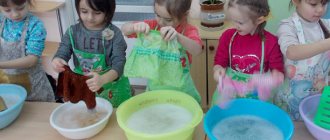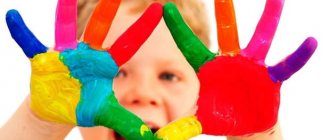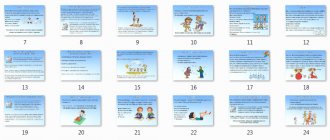Physical activity of children during the day
The tiger arches his back - deeply, deeply! (bend your back back)
The squirrels are sitting on a branch there, we will jump like squirrels! (jumping on two legs)
They closed the zoo, closed the doors, and the guys, like mice, sat quietly, quietly.
Breathing exercises
A study of the work experience of many preschool teachers shows that breathing exercises are among the most popular types of health-saving technologies in preschool educational institutions. It is a system of breathing exercises that are part of a complex of correctional work to strengthen the general health of the child.
Using breathing exercises helps:
improve the functioning of internal organs;
activate cerebral circulation, increase oxygen saturation of the body;
train the breathing apparatus;
prevent respiratory diseases;
increase the body's defense mechanisms;
restore peace of mind, calm down;
develop speech breathing.
During breathing exercises, the following rules must be observed. It is recommended to carry it out in a well-ventilated room and before eating. Such exercises should be daily and last 3-6 minutes. To perform breathing exercises, you do not need any special clothing, but you need to make sure that it does not restrict the child’s movements.
During the exercises, you need to pay special attention to the nature of your inhalations and exhalations. Children should be taught to inhale through the nose (inhalations should be short and light) and exhale through the mouth (exhalation should be long). Breathing exercises also include breath-holding exercises. It is important that children do not tense their body muscles or move their shoulders when performing exercises to develop speech breathing.
For example:
Exercise "Steam Locomotive".
Chug, chug locomotive,
He took me far
For the forests, for the seas,
Where miracles happen.
(children squat down and hum - take a deep breath and exhale “Too-too-too”)
Exercise "Lumberjack".
The woodcutter came to us
And he chopped our wood!
(Hands clasped above your head, inhale through your nose, as you exhale, sharply lower your arms, exhale through your mouth, say “Wow!”)
Finger gymnastics
Finger gymnastics is a type of health-saving technology that is used not only to develop fine motor skills of the hands (which is important for preparing a child for drawing, modeling and writing), but also to solve problems with speech development in children. In addition, such gymnastics promotes the development of:
tactile sensations;
coordination of movements of fingers and hands;
creative abilities of preschool children.
During classes or during the day, at regular moments, finger games or finger massage are included. In Eastern medicine, there is a belief that massaging the thumb increases brain activity, the index finger has a positive effect on the stomach, the middle finger on the intestines, the ring finger on the liver and kidneys, and the little finger on the heart.
Organization of independent motor activity of children in preschool educational institutions.
Author: Gorbacheva Lyudmila Viktorovna
teacher at the Lukomorye Medical Educational Institution, Noyabrsk
Organization of independent motor activity of children in preschool educational institutions.
Organization of independent motor activity of children in preschool educational institutions.
The intensity of children's physical development and their health directly depends on physical activity. So J. Tissot said: “Movement is the main source of health.”
In order to increase motor activity, the system of physical education of preschool children in a children's educational institution must include various forms of physical exercise: morning exercises, physical education classes, outdoor games and exercises in the fresh air, elements of sports games, gymnastics after a nap, invigorating gymnastics, physical education leisure, holidays, health days, visiting children's sports sections, swimming, exercise therapy and massage, because We all know that a preschooler’s daily physical activity should be at least 1 hour, per week: 5-6 hours.
These types of motor activities complement and enrich each other and thereby provide the necessary motor activity for each child during the entire time of his stay in the preschool educational institution.
Motor warm-up during a long break between classes allows you to actively relax after mental stress and forced posture. It consists of 3-4 exercises, as well as voluntary movements of children using a variety of physical education aids. At the end of the warm-up, it is rational to do a relaxation exercise for 1–2 minutes. Long warm-up no more than 10 minutes.
After a nap, it is important to improve the mood and muscle tone of each child, as well as take care of the prevention of posture and foot problems. This can be facilitated by a complex of gymnastics after a nap.
But the independent motor activity of children, about the benefits of which much has been written, is an excellent means of physical and emotional development of the individual. This is an activity that occurs on the initiative of the child. Its advantage is that the child himself chooses the type of movement, pace, pauses, and alternates them.
Independent motor activity of children is organized at different times of the day: in the morning before breakfast, between classes, during play hours after naps and during walks (morning and evening).
Active actions of children should alternate with calmer activities. It is important to take into account the individual characteristics of each child and his well-being. In exercises and games with children, the personal example of the teacher is very important. Therefore, he must be able to ski, skate, play tennis, etc. Individual characteristics are clearly visible in the independent activities of older preschoolers.
Management of independent motor activity provides for the following mandatory points:
-organization of a physical education and play environment: sufficient space for movement; optimal quantity, variety, rotation of benefits;
- fixing time in the daily routine for independent motor activity of children without fail during the morning reception, before and between classes, during a walk, after sleep, in the evening;
- teachers’ knowledge of special (indirect) methods for activating children’s movements.
All management is based only on an individual approach.
It is necessary to:
-observe children, be able to see everyone and, if necessary, provide assistance;
-involve children in placing physical education aids in the group, on the site, thereby stimulating the desire to perform certain movements;
-relieve tension and constraint of individual children with a smile and encouragement; if the child finds it difficult, help him choose a movement aid with a question, riddle, or advice;
- try, without imposition, to unite children of different mobility in joint pair play, providing them with one object for two (ball, hoop, jump rope, etc.) and showing options for action, if necessary;
- do not force an active child to sit down; on the contrary, with the help of a plot, bring purposefulness into his aimless actions;
- sometimes engage in joint play with one of the children in order to show new movements or actions, to arouse interest in them;
- play with new aids, showing how differently you can act with them.
- periodically, together with children, build “obstacle courses” from available aids and encourage them to overcome them “in different ways”;
-enrich children’s role-playing games with a variety of types and methods of all basic movements.
Independent activity, developing in children the ability to choose and perform (without the help of adults) physical exercises, at the same time fosters initiative, activity, organizational skills, and creative activity. For example, younger preschoolers already in the middle of the school year (due to systematic work in this direction) are able to independently come up with new movements and exercises with known manuals; older preschoolers - enrich familiar outdoor games with a large number of options, as well as create new ones.
All kindergarten students, regardless of age, can engage in physical exercise independently, individually and in small groups. The material is those exercises that, without requiring complex organization and insurance, most effectively affect the child’s body: crawling, exercises with a ball, jumping over a long and short rope, throwing at a target, running; cycling and scooter riding, badminton, tennis, ring throwing, outdoor and other games. Proper organization of independent motor activity will help improve health, expand motor experience, develop a strong interest in physical exercise, skills of self-organization and communication with peers, and develop creativity.
In addition, you can conduct daily 15-minute classes, conventionally called independent motor training.
To conduct them in a gym or group, a sufficiently large area for movement is freed up, and physical education equipment is prepared. Children enter the hall in lightweight clothing and comfortable shoes.
It is advisable to use simple, familiar aids to children (for example, a ball, a hoop, a jump rope), in small quantities (2-3 for each child). They should be placed in such a way that the space for movement is not limited, each child has the opportunity to freely access them (for example, hoops are laid out in a row along one wall, balls on another, jump ropes on a third).
Each training begins with motivation of motor activity. Children are given a specific task that stimulates the child’s physical activity.
Example tasks that stimulate motor activity:
- Guys, try to show as many movements as possible with any object that you like
- Take one object and create different movements with it
- Create a movement with any two objects
- Today you will perform the movements in pairs. Take any one object and perform as many different movements as possible
- Each person choose the tutorial that they like the most, and then pair up in pairs if desired and try to perform different movements together with two objects
- Try to team up with three people. Choose any manuals, build a path, and then everyone will come up with their own movements on it (as many as possible). Let's see who can come up with the most moves
- The task of today's lesson is to come up with as many movements as possible and count their number
- Today, everyone must demonstrate for all the children the movement that they love most.
Let me remind you once again that physical education and health work with preschool children is planned in accordance with the principles of consistency, systematicity, and comprehensive use of the natural forces of nature and hygienic factors, as well as health-improving methods and taking into account the individual characteristics of preschoolers.
By instilling in children the need to move daily and do physical exercise from an early age, you can lay a solid foundation for good health and harmonious development.
Prepared by the teacher of the Lukomorye Medical Educational Institution:
Gorbacheva L.V.
In the morning and evening before routine activities, during a walk
MOTOR MODE MODEL
preparatory group
| Motor mode | Algorithm | Duration | Note |
| Morning exercises | daily | 10-12 min | Number of outdoor switchgear: 8-10 (repeats 5-6 times) The complex is compiled for 2 weeks. Forms of conducting classes: traditional, game, plot-game |
| Musical activity | 2 times per week | ||
| Physical education lesson | 3 times a week | 30 min intro.h – 3-5 min. Main part – 21-26 m. Conclusion h. – 3-4 min. | Number of outdoor switchgear: 4-5 (repetitions 4-5 times), Number of O.D.: 2-3 (one new), Forms of conducting classes: traditional, game, based on a single game plot |
| Physical education minute | Of necessity | 1-3 min | Complexes are selected taking into account the nature of previous classes. |
| Outdoor games during walks, during special moments | daily | 10 -15 min | 2-3 games of different mobility |
| 1 time per week | According to the program and time of year | ||
| 1 time per week | 15 minutes | According to the plan of educational work | |
| Development of movements while walking and during routine moments | daily | 10-15 min | based on the results of physical education classes, by health group |
| Physical education | 1 time per week | 40 min. | 2nd week of the month |
| Health Week | 2 times per year: February | 2nd week of the month | |
| Health Day | daily | 15 minutes | 1st week of the month |
| Active motor rise | daily | 15 minutes | After sleep |
| Breathing exercises | daily | 1-2 exercise | It is used during morning and invigorating exercises after sleep, physical education classes, and in individual work with children. |
| Ind. slave. with children on movement development | daily | 5-10 min |
In the morning and evening before routine activities, during a walk
MOTOR MODE MODEL
Senior group
| Motor mode | Algorithm | Duration | Note |
| Morning exercises | daily | 8-10 min | Number of outdoor switchgear: 6-8 (repetitions 4-5 times) The complex will take place for 2 weeks. Forms of conducting classes: traditional, game, plot-game |
| Musical activity | 2 times per week | ||
| Physical education lesson | 3 times a week | 25 min introductory h. – 3-4 min. Main part - 15-22 m. Closing hour - 3-4 min. | Number of outdoor switchgear: 6-8 (repetitions 4-5 times), Number of O.D.: 2-3 (one new), Forms of conducting classes: traditional, game, based on a single game plot |
| Physical education minute | Of necessity | 1-3 min | Complexes are selected taking into account the nature of previous classes. |
| Outdoor games during walks, during special moments | daily | 10 -15 min | 2-3 games of different mobility |
| 1 time per week | According to the program and time of year | ||
| 1 time per week | 15 minutes | According to the plan of educational work | |
| Development of movements while walking and during routine moments | daily | 10-15 min | based on the results of physical education classes, by health group |
| Physical education | 1 time per week | 15-20 min. | 2nd week of the month |
| Health Week | 2 times per year: February | 2nd week of the month | |
| Health Day | daily | 15 minutes | 1st week of the month |
| Active motor rise | daily | 15-20 min | After sleep |
| Breathing exercises | daily | 5-10 min |




